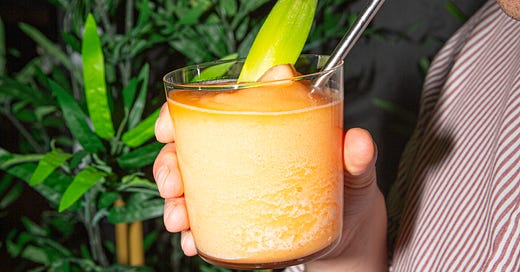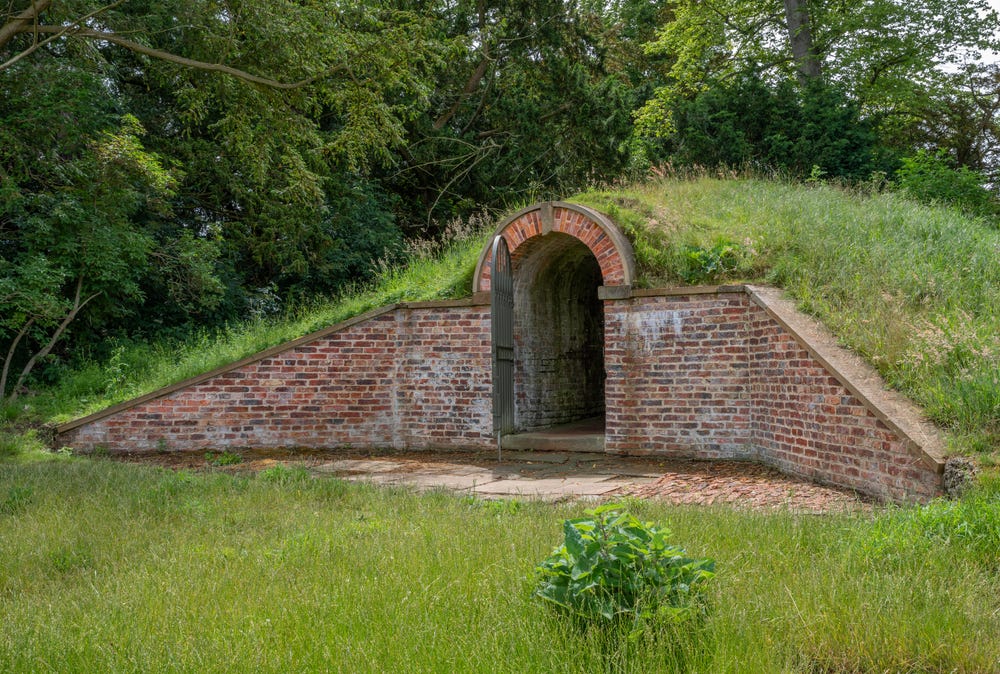Thanks for opening this month’s Food Team newsletter! It has been hot in London this month. While the boys are pretty relaxed when it comes to rules around the office, we thought a studio ice-bath might have pushed them a little too far. Instead, we delved into the history of ice and found it far more interesting than we could have imagined… Genuinely! Read on a little further for three recipes inspired by our ice-cold deep dive.
Slater: Keeping cool in London wasn’t always this easy. In fact, it really wasn’t that easy for most people well into the 20th century. In 1969, while Neil Armstrong was waltzing on the moon for the first time, only just over half of households in the UK had a fridge, let alone a freezer. Before that, the city relied on ice factories that created mammoth blocks of ice with steam powered compressors borne from the industrial revolution. Up until this point, ice had been a luxury for the rich, harvested from the arctic circle and shipped around the world in very large blocks to be stored in specially built ice houses underground.
The more daring would harvest ice from the heavily polluted Thames that ran through London when it was cold enough. It was colder back then. The river would freeze to the extent that ‘frost fairs’ would be held down its length in a time now referred to as the “little ice age” between the 1300’s and 1800s. If you walk under Southwark bridge, you can see large slabs of slate engraved with depictions of food stalls set up in gazebos down the length of the river and boats on wheels, being pulled by men transporting goods that would have floated a few months earlier. The irony was, that while the city was at its coldest, only the rich could benefit from ice. Ice cream parlours selling flavours that we might recognise today like pistachio started to pop up in Central London towards the end of Europe’s 500 year cold snap.
By the time Queen Victoria had come to reign in the mid 1800’s, the price of ice and, importantly, sugar had equalised to the extent where ice-cream was available for all, but it didn’t come without its dangers. Ice-cream would be sold to the working class of London from “penny licks”, which were cones made from glass that would be loaded with ice cream and distributed from carts. The penny licks would be handed back to the ice cream sellers, seldom rinsed, then loaded again with ice cream for the next customer, aiding the spread of all sorts of deadly diseases. As the world learnt more about infection and bacteria towards the end of the century, penny licks were banned and pastry cones were first patented by a New York-based ice cream salesman, which quickly made their way over the pond.
By the time our current King’s great great grandfather’s reign was in full swing, London was pretty much consuming regular scoops of ice-cream and even ice-cream wafer sandwiches in a similar fashion as we might today. Ice-cream innovation stagnated for the next 50 years as the world went to war and sweet treats weren’t top of the global agenda. But in the 1960’s ice cream vans and, importantly, soft serve ice cream machines hit the capital’s streets… thanks, in part to a little-known chemist by the name of Margaret Thatcher. The woman, who would go on to govern the country 20 or so years later, spent the 1950’s developing ice-cream emulsifiers to keep your Mr Whippy… whipped.
It was time to take a break after researching all-things ice for what felt like too long. There is a little supermarket not far from the studio that sells ice lollies from a chest freezer at the front. I hastily unwrapped my Cornetto and tucked in as soon as I left through the sliding doors. Thanks to some clever development in the late 50’s, a layer of thick chocolate helped to insulate the ice-cream inside the cone, time still seemed of the essence in the Summer sun. As cold creamy waves of synthetic vanilla and cheap chocolate hit my tongue, I felt a sizeable sense of gratitude for something that, a few hours earlier, I would have probably taken for granted.
Ice Cold Pea and Herb Soup with Lemony Ricotta
Serves 2
Gazpacho is a fantastic soup to eat when the weather is hot, but if you are after something a little more… green, this soup might be the one for you! A good, high-powered blender is key here for the best results.
For the soup
600ml good chicken stock
400g frozen peas
20g chives
15g parsley, leaves
10g tarragon, leaves
1 clove garlic, peeled
1 tbsp sherry vinegar
4 tbsp extra virgin olive oil
For the ricotta
125g ricotta
1 lemon, zest and juice
4 tbsp extra virgin olive oil
To serve
Crushed ice
2 tbsp extra virgin olive oil
5g chives, cut into 1cm lengths
Heat the stock in a large pan over a high heat. Once the stock starts to boil, add the peas, herbs and finely grate in the garlic. Season with salt and boil for 6-8 minutes, until the peas are soft.
Transfer to a high-powered blender along with the vinegar, but reserve ½ the cooking liquid. Blitz until silky smooth, then blend in the olive oil, season to taste with salt and chill in a bowl set over ice.
Add the ricotta, lemon zest, juice and olive oil to the bowl of a small food processor. Season with salt and pepper, then blitz until smooth and mayo-like. Chill in the fridge ready for serving, you can do this in a large mixing bowl with a whisk and plenty of elbow grease if you don’t have a food processor!
Once the soup is fridge-cold, divide it between bowls and scatter in small handfuls of crushed ice to keep it that way. Drizzle over good oil, scoop in mounds of the whipped ricotta, then finish with the chives. Tuck in!
Beetroot Ripple White Chocolate Ice-Cream
Serves 6
Beetroot might not sound like a natural bedfellow with white chocolate, but its earthy flavours lend themselves well to this grown-up play on a British classic. While plenty of “no churn” ice cream recipes exist, this is not one of them - if you are as into ice-cream as we are, an ice-cream machine will make for a very worthwhile investment.
For the ice-cream base
250ml whole milk
400ml double cream
1 tsp vanilla bean paste or extract
2 tbsp liquid glucose
6 egg yolks
75g caster sugar
100g white chocolate
For the beetroot ripple
275g cooked beetroot
150g caster sugar
Heat the milk, cream, vanilla and glucose in a saucepan over a medium heat. Lightly beat the yolks with the sugar in a large bowl while the cream mix comes up to a bubble.
Once the cream mix starts to bubble, slowly beat it into the eggs, then return to the pan. Heat the mix up over a medium heat, stirring all the while, until it coats the back of the spoon. If you have a thermometer, you are aiming for about 84°C. Tip the custard into a clean bowl through a sieve. Add the white chocolate and allow it to melt into the mixture, stirring all the while. Chill in the fridge.
To make the beetroot ripple, blitz the beetroot and sugar together in a high-powered blender, until silky smooth. Transfer to a small saucepan over a medium-high heat. Once it starts to boil, reduce the heat to low. Simmer for a further 6-8 minutes, until thickened slightly.
Transfer the beetroot to a bowl and chill.
Once the custard base has chilled, transfer to an ice-cream machine and churn until thick. Whack a container in the freezer while you wait.
Once the ice-cream is ready, transfer half of it to the frozen container. If the beetroot mix has set, quickly blast it in the microwave, until liquid. Drizzle half of the beetroot mix over the ice-cream, use a knife to ripple it through the ice-cream to create streaks. Repeat with the remaining ice-cream and beetroot ripple.
Pop a lid on the container and freeze for at least 1 hour, until scoopable.
Blended East 8 Hold-Up
Serves 2
Marshall came in primarily to teach me how not to screw up an espresso martini earlier in the month, you can see that video on the channel soon. But we had a little more time on our hands. We asked him for his favourite blended cocktail, and with very little hesitation, this was the drink he taught us.
Blended drinks are a great option if you lack cocktail kit and/or you are catering for a crowd - we made a massive batch of this tropical winner for team drinks in mere minutes. We have given the quantities in grams here, so you can whack the blender jug onto the scales and keep everything super simple.
80g vodka
40g Aperol
30g passionfruit syrup
30g fresh lime juice
150g frozen pineapple chunks
100g ice
To serve
2 pineapple fronds
Blend all the ingredients in a high-powered blender, until smooth and pourable. Under-blending the cocktail will make it too thick, over-blending the cocktail will make it too thin.
Pour into cold glasses, garnish each with a pineapple frond and serve!








Whooooaaaa, these recipes! SAVING! I use beetroot in my smoothies or smoothie bowls. The health benefits are great, but the color!!!